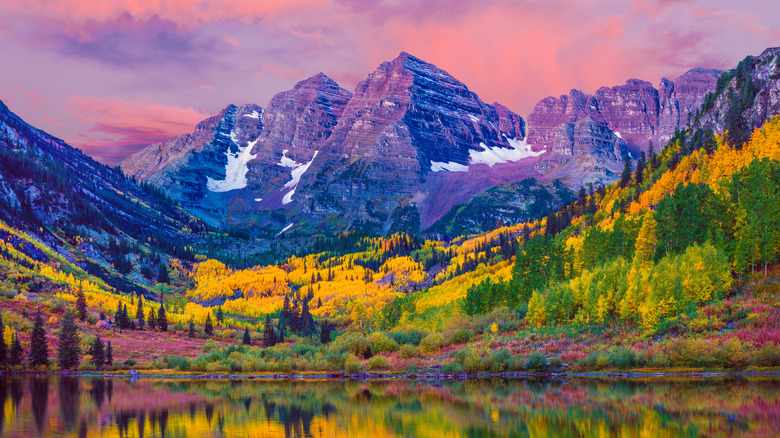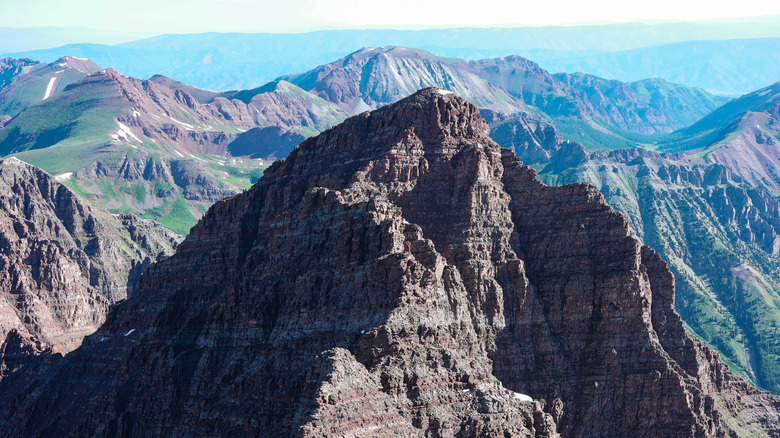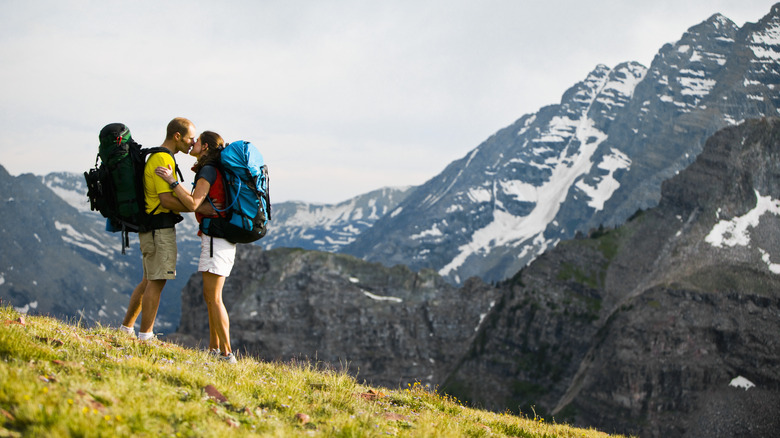The Unsettling Reason This Iconic Colorado Hike Has Earned Such A Scary Nickname
Maroon Bells Scenic Area has the distinction of being the most-photographed place in all of hyper-scenic Colorado, taking its name from the rusted iron in the siltstone that forms its two jutting peaks. When the mountains are framed by bright yellow aspens in autumn and reflected in the glassy surface of Maroon Lake during the alpenglow of sunrise (pictured above), it's hard to believe how achingly beautiful the scenery is. But while there is safe hiking aplenty here, the danger of climbing to the top of these peaks has earned them the moniker "Deadly Bells."
In 2017, a 27-year-old soldier and a 57-year-old woman died in separate incidents. In 2019, a 61-year-old man died in a 200-foot fall. In 2020, a 43 year-old man fell hundreds of feet down a gully to his death. At least 10 people have died on the Deadly Bells since 2000, but the mountain got its nickname in 1965, when eight people died in a single season. The Bells are arguably even more dangerous than Longs Peak, Colorado's other deadly mountain, where many of the incidents are due to climber inexperience. On the Deadly Bells, it's the terrain that's untrustworthy, not necessarily the climbers — even veterans can come to an untimely end.
What makes the Maroon Bells so Deadly
The mudstone that gives the mountains their rich red coloration is also notoriously crumbly underfoot — what mountaineers and climbers refer to as "rotten rock." Because the rock is so unstable, this climb isn't really safe for anyone, experienced or not. A sign (via Reddit) posted at the start of the climb reads, in part: "The rock is downsloping, rotten, loose, and unstable. It kills quickly and without warning. The snowfields are treacherous, poorly consolidated, and no place for a novice climber. The gullies are death traps. Expert climbers who did not know the routes have died on these peaks."
You'd think such a stern warning would scare climbers off the mountains, but you'd be wrong. Enough climb it that local Search & Rescue has to perform up to 12 rescue operations every year. Many climbers attempt these mountains in an effort to summit of all 58 of Colorado's "14ers," mountains above 14,000 feet in elevation. And unlike the deadly hike to Angel's Landing in Utah, this one requires no permits at all, just a parking or shuttle reservation to get to the trailhead.
Safe ways to play in the Maroon Bells Scenic Area
Nearby Aspen has long been a ski bum's idea of paradise, but it is gaining traction as a summer playground for birdwatchers and backpackers. Maroon Bells is an Aspen backpacker's dream destination. The Four Pass Loop around the base of the twin Maroon Bells is as famous for its beauty as the peaks are for their deadliness. This is a rigorous trip. You'll want three or four days to backpack just 26 miles, because the entire route is at altitude, including four 12,000-foot mountain passes. If you're used to sea-level exploits, this will humble you. AllTrails users report crossing snowfields well into July, but comments like "Most beautiful views I've ever seen," and "The most stunning hike in Colorado I've ever been on" are common. You might share the scenery with moose, mountain goats, or brown bears, and if you're camping, you're required to store your food in a bear-proof container.
For a little less elevation, a simple 17-mile overnight backpacking excursion to Conundrum Hot Springs is no conundrum at all — more like a no-brainer. Hike through wildflower meadows and aspen groves to a rock-ringed pool where you can soak and stargaze before climbing into your downy sleeping bag, and wake up to watch the sunrise on those maroon peaks. Trust us, this is a lot better way to appreciate their beauty than by climbing their risky, rocky flanks.


